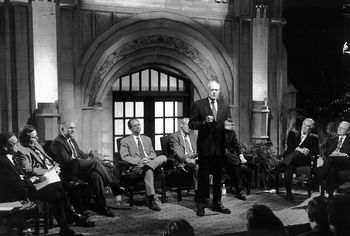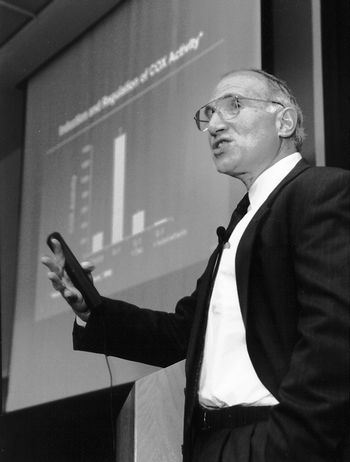Clarity key when explaining research to public: panel

Chancellor Joe B. Wyatt kicked off the panel discussion at Light Hall on Tuesday. (Photo by Donna Jones Bailey)

Monsanto Co.'s Phillip Needleman, Ph.D., was the event's keynote speaker. (Photo by Donna Jones Bailey)
What's it mean to me?
That's the question the public is asking, and scientists have a duty to answer, panelists agreed Tuesday night in the first event of what is envisioned as a "Vanderbilt Discovery Series" to inform the community about biomedical research.
Chancellor Joe B. Wyatt introduced the roundtable discussion, which brought together representatives of science, government and business, as a way to help the public understand "the journey from research bench to the patient bedside."
"We have a responsibility to translate our work," said Lawrence J. Marnett, Ph.D., Mary Geddes Stahlman Professor of Cancer Research and director of research for the Vanderbilt Cancer Center. "After all, we're funded by the National Institutes of Health, not the National Institute of Hobbies. The taxpayers expect us to do something relevant with our work. Beyond that, it's more fun. There's tremendous benefit and satisfaction doing something that might help someone someday."
The roundtable discussion before an audience of community members specifically focused on the journey "from discovery to drugstore" of a new class of drugs ‹ often touted as "better" or "super aspirins." These new drugs, known in the scientific community as COX2 inhibitors, are generating a great deal of excitement as they move toward FDA approval because they promise the benefits of aspirin without stomach upset.
Veteran journalist Jim Hartz, who moderated the discussion, began the event by holding up the "two most widely used drugs" ‹ nicotine delivered in the form of a cigarette and an aspirin. His point: even the common aspirin, which has been in our medicine cabinets for a century, isn't without potentially serious side effects. An estimated 100,000 people are hospitalized with aspirin- or NSAIDs-related gastrointestinal bleeding each year and about 16,000 of them die.
Scientists on the panel explained why a "better aspirin" is needed and how their work fits into that goal. They were joined by Mayor Phil Bredesen, who put the research into community perspective; venture capitalist Dr. T. Forcht Dagi, who offered insights into the role of private investors in supporting cutting-edge research; and Dr. Harry R. Jacobson, vice chancellor for Health Affairs, who highlighted VUMC's institutional commitment to capturing the commercial potential of discoveries.
Philip Needleman, Ph.D., senior vice president and chief scientist at Monsanto Co. and president for research and development at G.D. Searle and Company, described the background work that suggested the existence of a second target enzyme for aspirin and other non-steroidal anti-inflammatory drugs (NSAIDs). This second enzyme, called cyclooxygenase 2 (COX2), produces prostaglandins that cause pain and inflammation, while the first, COX1, produces prostaglandins that protect the stomach from irritation.
Their hypothesis sparked a search for this enzyme and ultimately the development of drugs to selectively target COX2. The result: drugs that have been shown in clinical trials to be equally effective to currently available NSAIDs in relieving pain and inflammation without the resulting risk of ulcers and other stomach damage.
"Aspirin is alright for a headache, but if you are have severe rheumatoid or osteoarthritis, you'd be shoving in handfuls of aspirin every few hours," Needleman said. "And you probably wouldn't get the relief you were looking for. Aspirin is not potent enough for severe disease, and it's dangerous to push the dose."
Treatment of arthritis and other chronic inflammatory conditions may just be the tip of the iceberg. Equally exciting are the potential implications of research in this field for other diseases, including the prevention of colon and other cancers.
"This area of research is very promising," Jacobson said. "We know that these prostaglandins have different sets of receptors in the body where they bind. Future drugs could be developed that might be even tissue specific and act on the unique subsets of prostaglandin receptors."
Marnett discussed work ongoing in the A.B. Hancock Jr. Memorial Laboratory for Cancer Research to create a new compound that irreversibly blocks COX2 without affecting COX1. This research could potentially lead to a new drug that provides longer-acting benefits than even the new COX2 inhibitors, which only temporarily tie up COX2.
He noted that drug development is not usually done in an academic setting. "Our work began as an intellectual exercise to prove the concept," said Marnett, who directs the Hancock Lab. "If this hadn't been such an important problem, we probably would have just published our results in a scientific journal, and that would have been it." The group is now moving through the process to test their new compounds in animals, a key step before human studies can begin.
Dr. Ray DuBois, Mina Cobb Wallace Professor of Gastroenterology and Cancer Prevention and director of Gastroenterology, noted that the ability to harness new information about COX2's role in the development of colon cancer had been constrained by the inability to selectively block COX2. DuBois and his collaborators are now studying the potential of the new COX2 inhibitors to prevent colon cancer.
"As a gastroenterologist, I know that ulcers and erosions of the stomach lining are a big problem, and we were concerned about giving someone an NSAID for colon cancer and then causing something else, like a bleeding ulcer, that was acute and would have to be dealt with," DuBois said.
Dr. L. Jackson Roberts II, professor of Pharmacology and Medicine, illustrated how research in the larger field of biology in which the cyclooxygenases fall ‹ biology involving arachidonic acid and its metabolites, eicosanoids ‹ may have implications for other common diseases as well. Roberts and his collaborators have discovered a way to measure a type of prostaglandin produced not by enzymes like COX1 and COX2 but by oxygen-free radicals.
"Free radicals are involved in cancer, in atherosclerosis, in neurological diseases," Roberts said. "That's why we hear about the need for taking vitamin E and vitamin C. But these antioxidant vitamins may not be the most effective way to do this. It may be that in addition to a better aspirin, we also need a better vitamin E, a better vitamin C."
Dagi predicted that emerging understanding about the mechanisms of disease and how the body responds to disease will revolutionize the way we look at drugs and at the practice of medicine.
"It's in this kind of research and this kind of institution where this happens," Dagi said.
Having that kind of institution in a community offers rewards beyond economic benefits, said Bredesen, a health care entrepreneur and a physicist by training.
"Our goal is to attract productive people to the community, and certainly the presence of a Vanderbilt is a major factor in that," Bredesen said. "You want people to know that there is world-class research facility in the community."
But he added that scientists have to work to bridge the communications gap with the public, through events such as the roundtable discussion, visits to schools and appearances before civic groups like the Rotary Club. "I don't think scientists have done a good job of explaining why what they do is important to a person laying brick for a living and whose tax dollars you need to support the research," Bredesen said.













